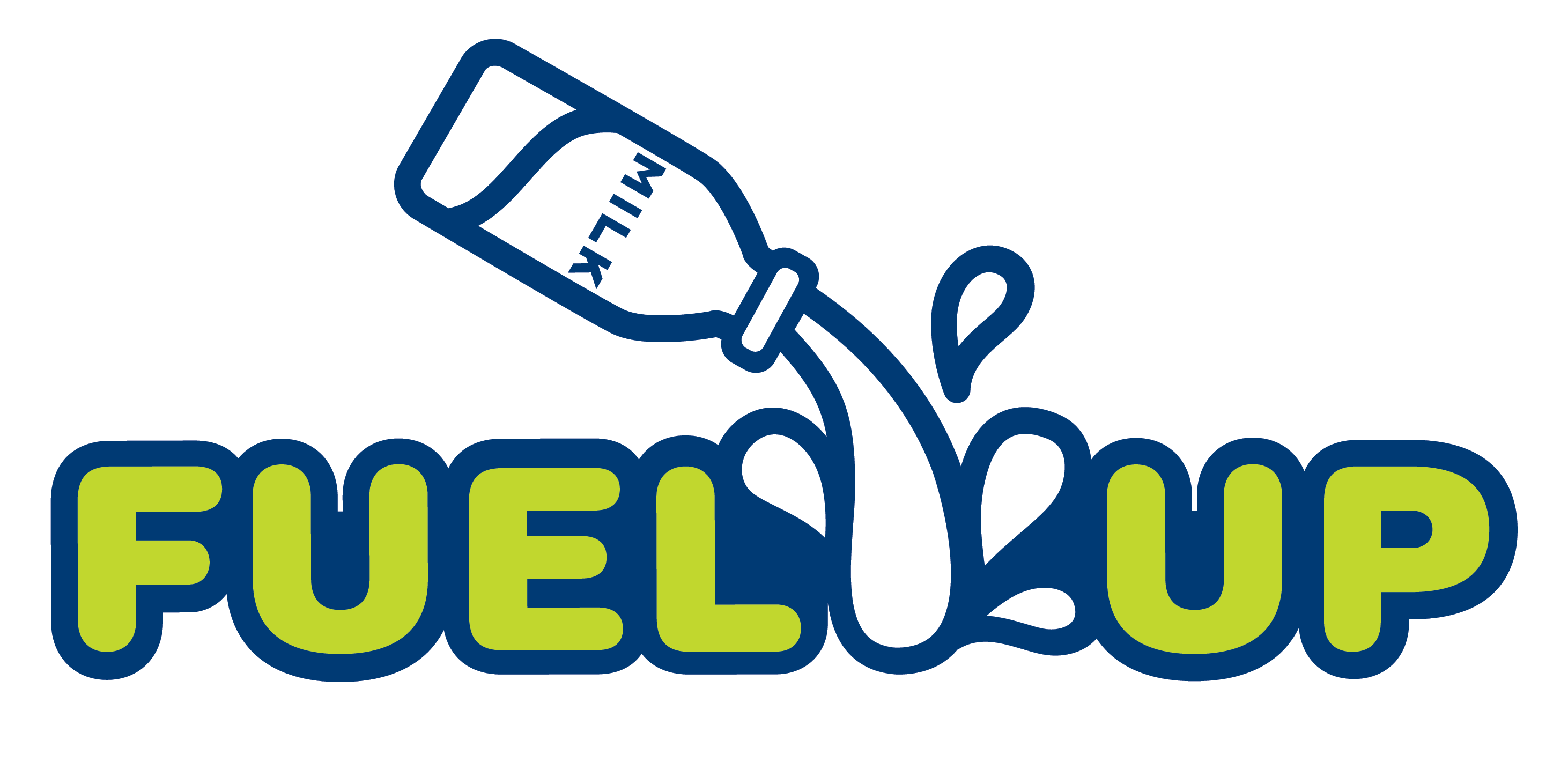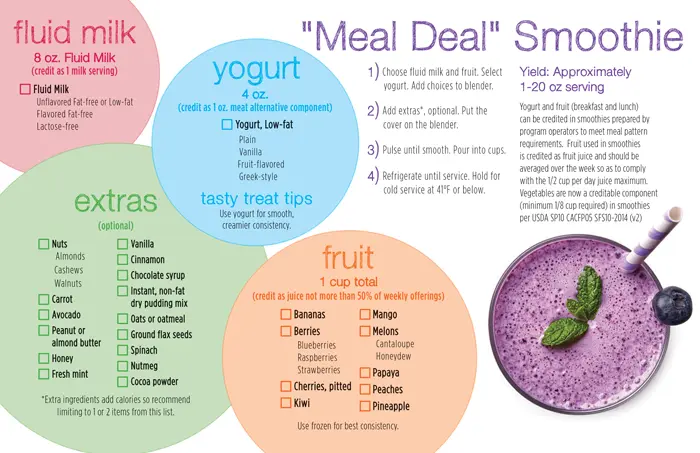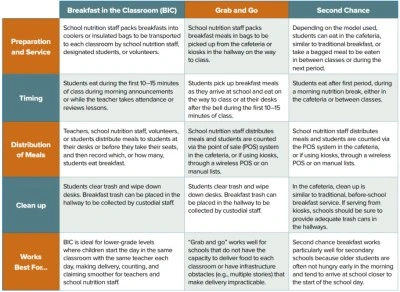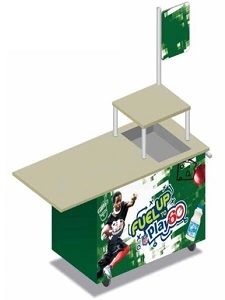OVERVIEW
What You'll Learn
What are the benefits of eating breakfast every morning? How can we help everyone get access to a nutritious breakfast?
What You'll Do
In this Play, you will select from three possible options for getting more students to eat breakfast at school: Breakfast in the Classroom, Grab-and-Go Breakfast and Breakfast after First Period (Second Chance Breakfast). Work with your school nutrition professionals to choose the program that works best for your school to help make a nutritious breakfast part of every student’s day!
Why This Play
Research shows that alternative breakfast programs can help get more students to eat school breakfast, which some studies suggest can help children, particularly those who are undernourished, do better in school — and it can be done without taking away from learning. With 1 in 6 kids in America is facing hunger – breakfast in the classroom is one strategy that can help fight hunger in schools. There are many ways to get more kids at your school eating breakfast and fueled up for success!
What to Do
There are three main steps to this Play. First, pick a program and get organized. Then, pick your menu, and finally – make it happen!
⚠️ Note: In any Play where you plan to work with school meals or à la carte offerings, you must involve the school nutrition director and other professionals! If that’s not you, be sure to contact that team before you get started.
Step 1: Pick a program
Pick a program and get organized. Click here to read about different breakfast programs: Breakfast in the Classroom, Grab-and-Go Breakfast or Breakfast after First Period (Second Chance Breakfast)? Each Play is different and can help increase breakfast participation and consumption. For middle school and high school, Grab-and-Go or Breakfast after First Period may work best. For elementary school, we recommend Breakfast in the Classroom. To help you decide which option will work best for your school, here is a chart followed by the first things you’ll need to do to get organized:
Grab-and-Go or Breakfast after First Period (Second Chance Breakfast)
- Pick a location. The best places are spots where students have frequent and easy access — where they get together to talk, eat and start the day off right.
- Choose a station design that really stands out.
- Maybe it’s a table with cool signs.
- Students can work with each other and some adult volunteers to build a kiosk or a cart on wheels.
- Does your menu plan include food that needs to be refrigerated? If so, factor that into your design.
- Click to see a catalog of equipment and consider applying for Fuel Up to Play 60 funds if you implement this Play!
- Consider how you will pack meals.
- You can prepackage meals in see-through containers so students know what they’re getting or give students a bag and let them pick from choices on the station.
- Try using fun, school-mascot or team-themed containers to boost interest.
- ⚠️ Note: Be sure if students are handling food that your school nutrition personnel are ensuring all food-safety measures are followed carefully.
- If students are offered choices, be sure to work with your school nutrition professionals to ensure students are choosing foods that create a reimbursable meal.
Breakfast in the Classroom
The key to making this program a success is to plan for a streamlined process and get teacher buy-in. This video will show you examples of both Breakfast in the Classroom and Grab-and-Go:
- Brainstorm food transport options.
- Can you use wagons like they show in the video? Some schools use laundry baskets.
- One thing that’s essential is to get students to help! Rotate student leaders from day to day or week to week so everyone gets involved.
- Plan for how you will keep hot foods hot and cold foods cold.
- Consider applying for funds to purchase insulated bags.
- Maybe a local grocery or sporting goods store will help.
- ⚠️ Note: It is critical for food safety to keep food at the proper temperature. Be sure school nutrition professionals are monitoring this.
Step 2: Plan your menu.
Work with your school nutrition professionals to choose the best menu options. Run some morning taste tests to introduce new ideas. For example, see how these middle schoolers in North Carolina helped with taste testing some breakfast pizza options (suggested budget of $0.60 per student, not covered by Fuel Up to Play 60 Funds).
The foods you select should be popular as well as nutritious. For example, nutritious breakfast bars may be a good option, but some breakfast bars are more nutritious than others. Ask the school nutrition manager for tips on what to look for in the ingredients list to help you make the best choice. Be sure to focus on menu planning that provides reimbursable meals!
Here are some great resources from National Dairy Council
- 12 new recipes brochure
- School recipe cards:
- And some to take home: home recipe cards
One great option to consider is to include smoothies (or other dairy-based beverages) — you can blend in dairy (low-fat or fat-free milk or yogurt), fruits and vegetables, and even whole grains.
- Check out these great recipes from National Dairy Council.
- You can also use these large-quantity smoothie recipes from USDA.
Another option, especially on cold mornings, is to offer hot low-fat or fat-free chocolate milk.
- Check out these resources from New England Dairy and Food Council that can help.
Think green.
- Use recyclable or reusable materials.
- Encourage students to finish what they choose for breakfast to help them get the nutrition from the milk, whole grains, fruits and so on — and to avoid food waste.
Step 3: Make it happen — and promote it!
- Set up a series of pilot days and invite different classes or student groups to participate. Get feedback from students and teachers and use that to refine your process.
- Pay attention to what students eat or don’t eat — and why.
- ⚠️ Note: If you haven’t already, check to see if your school qualifies for the Community Eligibility Provision, which allows schools to provide free breakfast and lunch to ALL students rather than just those who fill out school meal applications. It’s working in thousands of schools across the country!
Make your program known! Have students implement a breakfast marketing program like this one that was started by a school in Michigan.
Who Can Help
You are not in this alone. There are many people who can help make this Play a success, especially your school nutrition professionals. Meet with them first to talk about the three different breakfast ideas and which one seems the most “doable” in your school. Here’s a list of who can help with this Play and some specific ways they can do that.
School Nutrition Professionals
- Help with strategy and nutritious food selection
- Prepare breakfast foods and supervise volunteers
- Provide guidance to students on choosing foods that create a reimbursable meal
Principal
- Approve plan and location/breakfast type chosen
- Encourage support from with teachers and custodians
- Encourage student participation
Teachers
- Support breakfast option and encourage participation
Custodians
- Help create an efficient clean-up system for whichever program you choose
Students
- Encourage peers to participate
- Create posters promoting the new breakfast program
- Work with school administers to promote the new breakfast program during morning announcements
Families
- Encourage student participation
Community Businesses
- Donate materials and/or funds for a breakfast delivery system (kiosks or carts, insulated bags, wagons, etc., depending on breakfast choice)
School Transportation Personnel
- Encourage students to participate as they get off the bus
As with any game that’s worth playing and winning, you are bound to run into challenges. That's why getting help from others is so important. You’ll be more likely to achieve your goals when everyone works together.
Share this video to help explain how helpful it can be for all students to eat a nutritious school breakfast:
Build Interest
To help students start thinking about school breakfast and to help you get started with shorter activities, try some of these ideas:
- If you have or can get a salad bar setup, use it to plan a breakfast bar so students can sample different food options and rate them to see which might be added to the regular menu. This will help get the whole school excited about the menu because all the students can help choose it.
- Work with your school nutrition director to see how protein options can be included on the breakfast bar, like milk, yogurt, hard-boiled eggs and cheese.
- If you don’t have a salad bar setup, use some other part of the cafeteria meals line and consider applying for funds to get one!
Consider polling students about what they would grab on the go or eat in the classroom, or simply test a few ideas to see what works.
Create posters highlighting your program and the importance of eating a nutritious breakfast. Display them in high traffic areas, such as hallways, cafeterias and classrooms.
Send information home to parents or attend a PTA/PTO meeting to explain your breakfast program. Remember to mention the cost, location, benefits and menu options so parents and family members can spread the word when they go home.
Community
This section features ideas on ways to involve everyone in your school and community. Think about ideas for differentiating between older and younger students and ways to bring in the family connection.
Build student leadership opportunities. As much as possible, have students do the planning and run your programs.
For Older Students
- Look into the possibility of students earning service learning hours.
- Consider starting a “breakfast entrepreneurs’ club” so students can be empowered to build a business model for their school’s alternative breakfast service.
For All Students
- Have student volunteers work with your school nutrition professionals to host a one-time breakfast event in the school cafeteria. Check out this tip sheet and video that can help you make the connection between students and the nutrition team.
- Invite students, parents and community members to gather suggestions for alternative breakfast.
- Plan a video presentation (perhaps using videos in this Play) to get people engaged and show them how alternative breakfast service can work.
Put students in the driver’s seat as much as possible. They’ll learn valuable life lessons on how to plan and implement programs, and they’ll feel great about helping their school!
For Everyone
- Provide input on breakfast ideas and service options.
- Suggest grab-and-go locations or help create them.
- Talk to local businesses and parents to get their help with food, wagons or other serving equipment donations.
- Create posters highlighting the importance of a nutritious breakfast.
Homefield Advantage: Check out this resource and share it with parents and caretakers so they can see what they can do to help at home and at school.
Resources
- National Dairy Council: Breakfast Recipes and Resources
- FRAC and AFT: Breakfast Blueprint – Breakfast After the Bell Programs Support Learning
- USDA Community Eligibility Provision Resource Center
- Share our Strength: Hunger in Our Schools: Report 2017
- NEA Healthy Futures and Share our Strength: A Guide to Increasing School Breakfast Participation
- Food Research and Action Center: School Breakfast Program Resources







